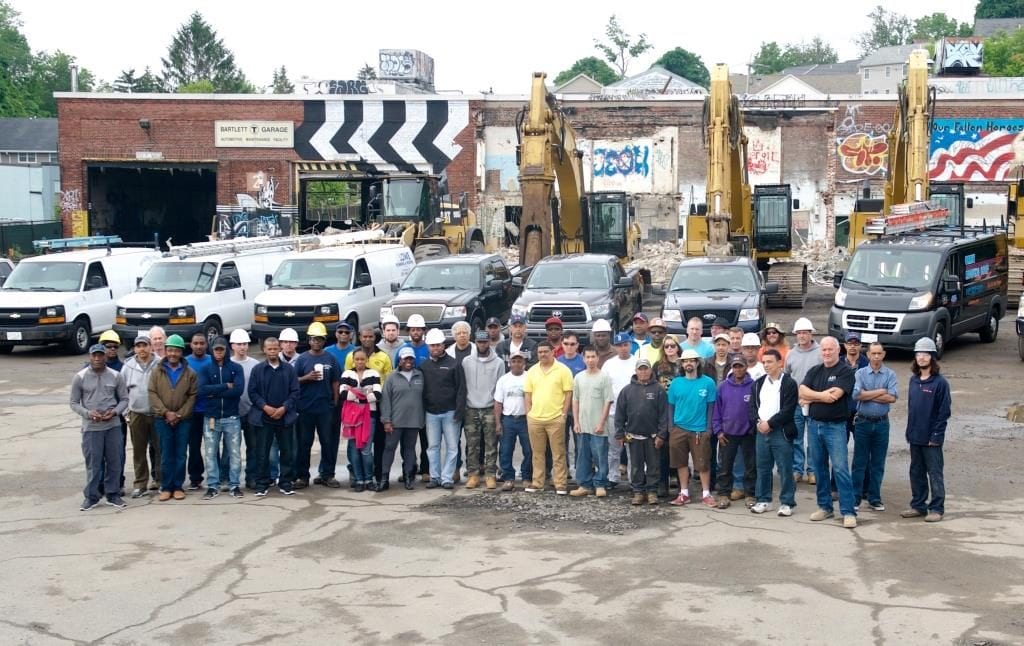
Knowing that employment status and income are key social determinants of health, Nuestra Comunidad Development Corporation was committed to ensuring jobs for workers of color and minority contractors at its Bartlett Station development in Roxbury, Massachusetts. Photo by Annette Grant
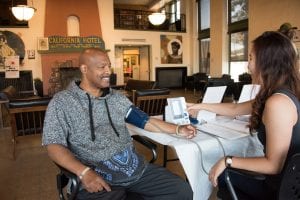
Gregory Brannon gets his blood pressure checked at the California Hotel, an EBALDC development that offers affordable apartments with community and commercial spaces. Photo courtesy of East Bay Asian Local Development Corporation
The shift has been unmistakable: health care organizations are increasingly focusing on upstream factors that affect their patients’ health. To some degree, that shift is the result of state and federal legislation, particularly the Affordable Care Act, which regulates nonprofit hospitals’ preventive care activities. But it’s also just common sense. Addressing patients’ big-picture realities—that is, the social determinants of health like housing, job creation, and food security—can have deep impacts on their day-to-day health and the interventions that are needed.
That new mindset has been a boon to many community development organizations, whose target populations—low-income groups—often tend to be frequent hospital users. The result has been a wide range of collaborations between community development groups and health care institutions that have sprung up around the country. In many cases, the partners have jointly determined that the community’s health problems could be mitigated through the provision of safe, healthy, affordable housing, often making housing development and rehab a front-and-center priority.
It’s a win-win situation: health care institutions save money as patients’ chronic conditions and repeat visits are reduced, while community development groups locate new sources of funding that can further their missions.
But how community development organizations should begin the process and start forging relationships with health care institutions isn’t easy or clear. “Everyone’s still trying to figure this out,” says Colby Dailey, managing director of Build Healthy Places Network, a nonprofit that connects the two sectors.
Dailey says hospitals and other health care organizations tend to be motivated by three main things: the regulatory environment, political incentives and the desire to curry favor with policymakers, and their own missions—which play a particularly strong role in Catholic hospital systems and children’s hospitals.
Community groups, says Dailey, “can think through how they may be able to assist the hospital in moving any of those goals forward—really understanding what the motivations are for an executive at a hospital.”
A community development organization can glean some of that by reading a hospital’s Community Health Needs Assessment (CHNA) and Community Health Improvement Plan (CHIP), both of which are public documents. The CHNA, in particular, outlines how a hospital views the challenges experienced by its patient community.
But the process isn’t a science. For most community groups—as well as for the health care institutions—it’s a messy, slow process, from commitment to locating and then connecting with a partner organization. “It is a long game,” says Dailey. “There’s beginning a relationship, and then working toward a more robust partnership that could span multiple areas of the organization.” There’s no blueprint.
Patience Pays Off
The relationship between Codman Square Neighborhood Development Corporation and Boston Medical Center could serve as a primer for how a partnership can blossom over time. In this case, the result so far has been substantial: an $800,000 investment by Boston Medical to help Codman Square NDC rehabilitate 34 rental housing units.
The two entities connected thanks to the Boston Alliance for Community Health (BACH), which brings together community development groups and health care organizations. “I sometimes call myself an organizational yenta,” says David Aronstein, BACH’s director. That matchmaking prowess comes in handy with two fields that often speak different languages. As Aronstein puts it, one side thinks the acronym “CDC” refers to a community development corporation; to the other, it’s obviously the Centers for Disease Control.
When you take it out to the community, the barriers aren’t just one or two; there’s dozens. So you’ve solved for one, but it’s like whack-a-mole: there are two others that pop up.
Three years ago, BACH was organizing the Boston branch of a national project called Alignment for Health Equity and Development (AHEAD) that brought together a cross-section of groups; in this case, the main issue was local food systems. Codman Square runs an urban farm and successfully applied to be part of the initiative. Through it, the organization’s staffers met a range of other groups, including representatives from Boston Medical Center.
Still, says Marcos Beleche, Codman Square’s associate director, “the strongest relationship was with the Boston Alliance for Community Health.” BACH was committed to helping Codman Square develop its urban farm—which empowers men of color.
Soon, another funding opportunity arose that could support the garden, one that required a hospital partner. “We were thinking, how do we really crack this nut about hospital benefits?” says Beleche.
It was BACH employees who suggested Boston Medical Center as a partner. And shortly after, one of Codman Square’s previous executive directors provided the current director with several names there; she had served on the hospital’s board of trustees and knew exactly who to reach out to. “And that led to a ‘we’d love to do this’” on Boston Medical’s part, says Beleche.
In the end, that particular grant didn’t come through—but Boston Medical offered to fund the urban farm itself. Soon after, the hospital mentioned that it was expanding its campus and had several million in community benefits funding to spend. “We’d love to work with you,” hospital officials said, according to Beleche.
Codman Square had recently acquired rental-housing units, many of whose residents were heavy health-service users. They were most likely going to Boston Medical, New England’s biggest safety-net hospital, figured BACH staff. Consequently, the hospital wound up investing $800,000 in the units’ rehabilitation, and because of Massachusetts’ tax credit program, it will recoup half of that funding.
The Codman Square people are excited and see this as a long-term partnership. “It’s a very significant relationship that’s going to influence how we do things going forward,” says Beleche.
A Forerunner in Examining the Social Determinants of Health
The East Bay Asian Local Development Corporation (EBALDC) has been something of an anomaly. The organization began focusing on the social determinants of health before it was fashionable, and has served as its own best advocate.
EBALDC became interested in the role that health played in the lives of its low-income client population back in 2011, when it recognized the overlap between low incomes and poor health outcomes on maps of Oakland. The group began focusing on health, and developed relationships with federally qualified health clinics in the communities where it worked.
In 2013, EBALDC received a national grant from the Partners in Progress initiative to bring together a cross section of stakeholders working in West Oakland. Several of the invitees were health-related entities, including Lifelong Medical Center, a community health care center.
“We decided to see if there was interest on the part of partners also working in those neighborhoods to collaborate around not just a single issue but the neighborhood and health and well-being there, and all the different things that impact that,” says Charise Fong, EBALDC’s chief operating officer.
The collaborative brought the organization national attention. At the same time, the leaders of Lifelong Medical Center introduced EBALDC to Sutter Health, a nonprofit health care network that operates a nearby hospital.
“Many of the patients [who] were repeat users of their emergency rooms were residents of West Oakland, and Sutter Health was interested in how our collaborative work could address residents’ needs before they got to the ER,” says Jill Kunishima, the organization’s director of development and communications.
Soon, Sutter joined as a partner. The organization contributed $25,000 as an “initial community benefits contribution,” and offered to share its data with EBALDC. The relationship solidified when the two organizations jointly applied for a large grant with BUILD Health. Sutter Health has since joined EBALDC as a partner in a second collaborative in East Oakland. Data sharing has remained a challenge, however, due to privacy concerns and the health care provider’s inexperience in sharing data with non-health care partners.
Finding Allies in Doctors
“They came to us initially,” says Kathy Schwab, executive director of Local Initiatives Support Corporation (LISC) of Greater Cincinnati and Northern Kentucky. She’s referring to doctors from Cincinnati Children’s Hospital, who sought out her organization to better understand how to help residents of the Avondale neighborhood, where the hospital is based.
That’s how LISC initially became involved with the children’s hospital. Nowadays, Schwab attends four or five meetings there each month: she’s on a governance committee overseeing the hospital’s traditional community benefits agreement ($10 million in housing investments and $1.5 million in capacity building grants for local nonprofits), and is on the leadership team for All Children Thrive, an innovative program that aims to improve children’s outcomes by focusing on their neighborhoods.
Which isn’t to say that she agrees with everything occurring at the hospital. LISC applied for $2 million of the housing rehab money and was rejected. Meanwhile, much of that funding was allocated for market-rate housing because the hospital wanted to bring up the market in Avondale. They were so successful that now the area’s affordable housing has to be stabilized.
And being part of All Children Thrive meant learning Improvement Science, the hospital’s rigorous methodology of testing various approaches. All community partners had to attend classes for six months to learn the methodology; then they applied it for over a year. Unsurprisingly, the biggest barrier to residents’ health turned out to be housing. “I could have told them that!” says Schwab.
The process was useful—Schwab says she’s seen Latino women in the community who were trained in Improvement Science for another program apply it to get rid of drug dealers in their building—but it has some drawbacks. “I think it works really well in a clinical setting. But when you take it out to the community, the barriers aren’t just one or two; there’s dozens,” says Schwab. “So you’ve solved for one, but it’s like whack-a-mole: there are two others that pop up.”
Perhaps the best part has been her relationship with the doctors, who are passionate and genuinely want to make a difference in the community. They’ve become advocates for housing-related issues—in fact, Schwab took the lead doctor from All Children Thrive with her to fight (unsuccessfully) for the housing funds LISC had applied for.
The doctors are still learning, of course. “What we’ve had to call them on is that they have to change their language. You can’t talk with medical terminology when you’re talking to families. Even sometimes with the leadership group, we’ll say, ‘We understand what you mean, but you really can’t say that,’” says Schwab. “That’s why they need community people—so we can break it down for them.”
Trust Was There From the Get-Go
It’s difficult to imagine a partnership going more swimmingly than the Invest Health program in Grand Rapids. The project—which is funded by the Robert Wood Johnson Foundation and the Reinvestment Fund—is composed of a range of stakeholders, including the city of Grand Rapids, Spectrum Health System, and the community development group LINC UP. What’s unique about the coalition, though, is that although the initiative began last year, most of the institutions have worked together extensively already.
“A lot of the people around the table, we’ve already had our arguments about what works and what doesn’t,” says Jeremy Moore, director of community health programs for Spectrum Health. “We’ve collaborated on other things, like political activities. The relationship building comes through with time spent.”
That understanding gave them a jumpstart. The group knew it wanted to focus on a historically segregated area of Grand Rapids in a highly collaborative manner, and it quickly developed five areas of focus: affordable housing, economic security, food security, healthy housing, and maternal-infant health. There’s been progress in all five areas, including a feasibility study to connect case management and home remediation, a grant to increase employment in the neighborhood, and a Low-Income Housing Tax Credit project to create new affordable housing. Spectrum has invested $10 million in the neighborhood.
The level of trust between the group’s members has helped in tangible ways, too. The tax credit project was spearheaded by LINC UP, but its application was originally rejected. On appeal, the organization asked the group’s members—including Spectrum—to explain the Invest Health program to MSHDC, the agency that administers the tax credit program. It worked: the organization was awarded $8.5 million. “Just [Spectrum’s] presence is huge, but they went above and beyond,” says Darel Ross, formerly the co-executive director of LINC UP and currently a director with the organization Start Garden.
Both Moore and Ross are energetic, ambitious men, and that clearly comes through in the work they do. After 18 months with the initiative, they realized that while health was deeply important, the bottom line was money and economic development in the neighborhood. “So Invest Health 2.0 is ‘wealth for health,’” says Ross. “Entrepreneurial development, homeownership—we’re looking at [the neighborhood] from a wealth standpoint, knowing that [income growth] impacts the social determinants of health.”
Still, they’ve run into some obstacles: namely, how to use data to illustrate their accomplishments. “When you’re talking about something new, at some level you have to be able to tell the data story in that,” says Moore. The problem, he says, is that community change—whether health, or wealth—tends to occur at a different pace than business or political cycles, and connecting those dots for a funder can be challenging. “If we’re realistic about it, community health and other investments are often working for the next generation, but that’s a terrible sell. That’s the tougher thing to navigate, and no one’s figured that out.”
A Hospital in Crisis, and a Slow Start
Three hundred and twenty-five miles to the southeast, another Invest Health initiative has been having a different experience. In Akron, a similar group—the city, neighborhood development organizations, and a big health care institution—began convening last year. Unlike in Grand Rapids, many were meeting one another for the first time. And one of the key players, Summa Health System, wasn’t able to contribute much.
The hospital was in the midst of a major crisis. It started with a rocky leadership transition, led to the termination of ER doctors’ contracts on New Year’s Eve 2016, and resulted in the loss of the hospital’s accreditation for its emergency medicine residency program.
Still, the hospital’s director of community benefits, Marlo Schmidt, got involved with the group as it conducted an assessment in its target neighborhood, Middlebury, determining needs, barriers, and neighbors’ own desires. The area’s residents said they wanted better housing, safer streets, and one more thing: “They would love more than anything to see a little family restaurant, a place where they can come together as a community,” says Terry Albanese, assistant to the mayor for education, health, and families.
The group eventually purchased a plot of land in the middle of the neighborhood, and East Akron Neighborhood Development Corporation (EANDC) applied for tax credits to build mixed-use housing there. At one point, there was hope that Summa might serve as the anchor tenant, but the hospital was in no position to make commitments. So the group is still looking for a tenant that can pull investment into the neighborhood, and is hoping to bring a neighborhood restaurant there eventually.
Albanese acknowledges that Summa, in this case, isn’t going to serve as the initiative’s “white hat” funder. But both she and Kyle Julien, director of urban planning for EANDC, agree that the group has benefitted from Summa’s presence.
“[Schmidt] is very knowledgeable about public health and would have input on how we were framing our discussion on the need for a healthier neighborhood,” says Julien. “It pushed me personally and in my role here, to think about tax credit development in a new way: thinking about the context, being able to assess positive outcomes in terms of health.”
Plus, says Julien, now his organization and Summa know each other. And though it may not bear fruit anytime soon, that’s still valuable. “As Summa comes out of that period of transition . . . there may be a relationship that we can establish that’s stronger as we move forward,” says Julien. “It’s not in any way a closed book.”

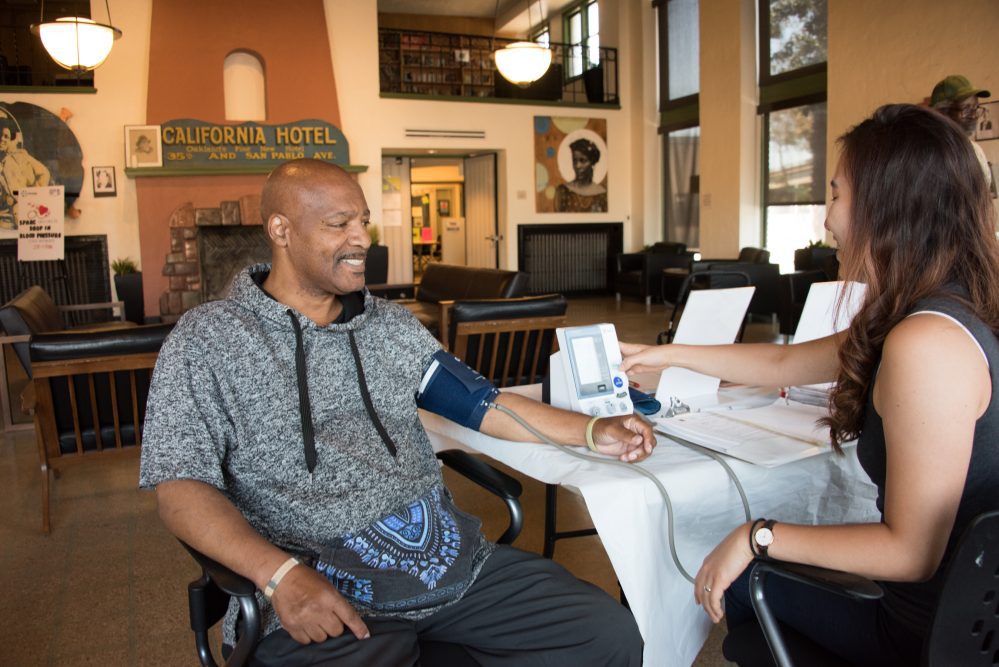

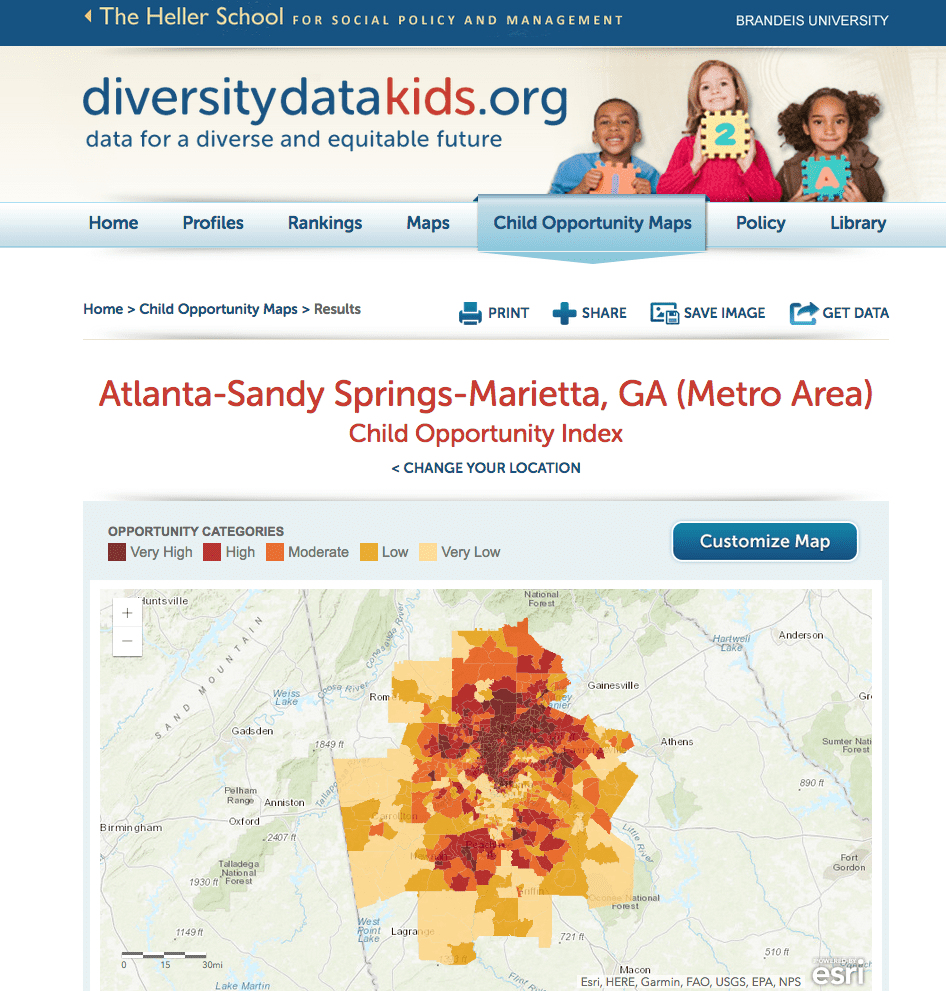

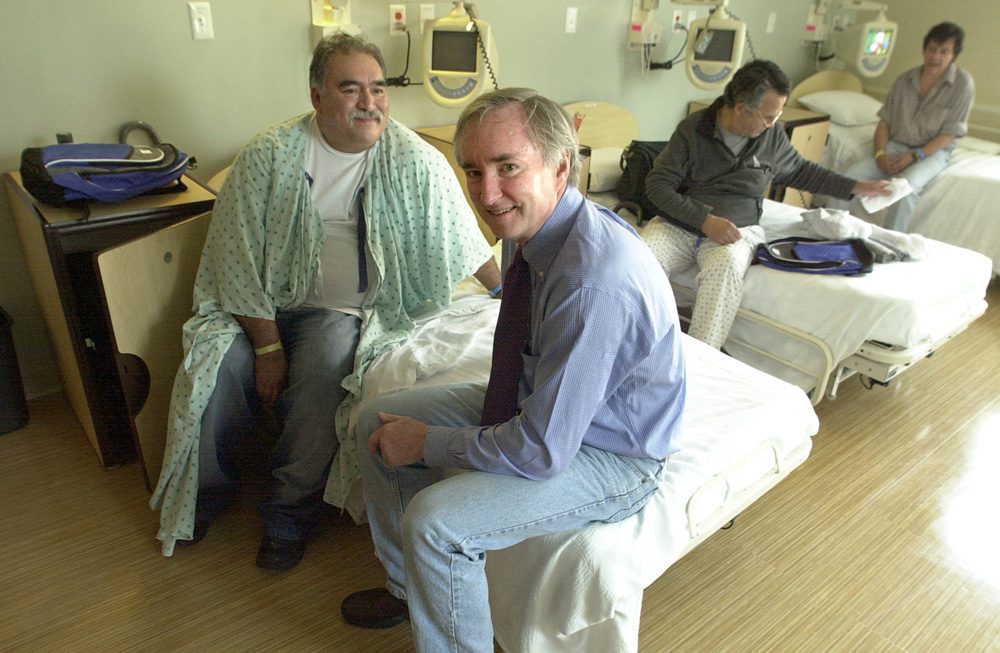
Comments